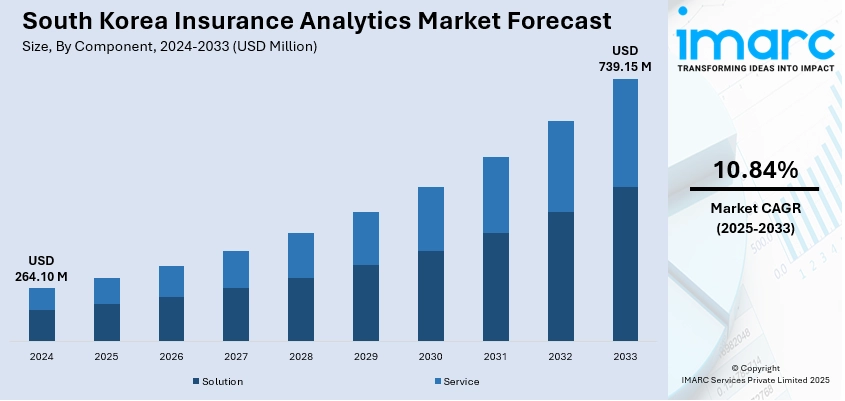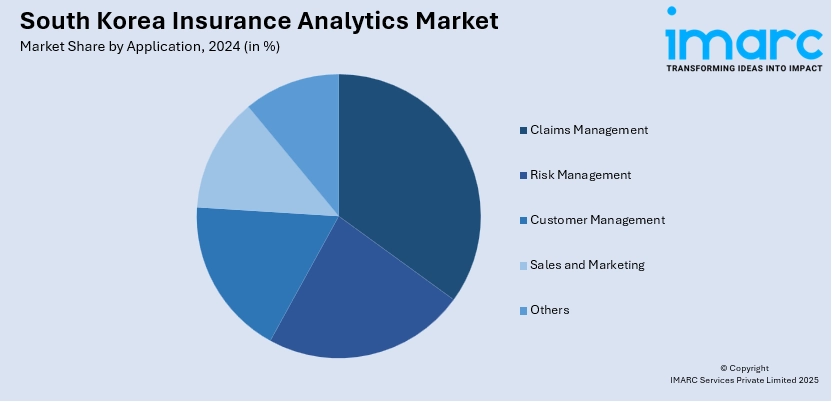
South Korea Insurance Analytics Market Size, Share, Trends and Forecast by Component, Deployment Mode, Enterprise Size, Application, End User, and Region, 2025-2033
South Korea Insurance Analytics Market Overview:
The South Korea insurance analytics market size reached USD 264.10 Million in 2024. The market is projected to reach USD 739.15 Million by 2033, exhibiting a growth rate (CAGR) of 10.84% during 2025-2033. AI technologies facilitate quicker and more precise risk evaluations, assisting insurance firms in enhancing underwriting and pricing approaches. Besides this, the swift expansion of health, life, and auto insurance segments is leading to the generation of large volumes of claims information that necessitates sophisticated solutions for efficient decision-making, fueling the South Korea insurance analytics market share.
|
Report Attribute
|
Key Statistics
|
|---|---|
|
Base Year
|
2024
|
|
Forecast Years
|
2025-2033
|
|
Historical Years
|
2019-2024
|
| Market Size in 2024 | USD 264.10 Million |
| Market Forecast in 2033 | USD 739.15 Million |
| Market Growth Rate 2025-2033 | 10.84% |
South Korea Insurance Analytics Market Trends:
Growing assimilation of AI
Rising adoption of AI is fueling the market growth in South Korea. AI technologies enable faster and more accurate risk assessments, helping insurance companies improve underwriting and pricing strategies. Through machine learning (ML) and predictive analytics, insurers can identify patterns in customer behavior, detect potential fraud, and streamline claims processing. These capabilities reduce operational costs and enhance decision-making, allowing companies to offer more personalized products and services. As competition is intensifying in the insurance sector, firms are adopting AI-based tools to gain deeper insights into customer needs, enhance engagement, and strengthen customer retention. Chatbots and virtual assistants powered by AI also improve customer service, offering real-time assistance and simplifying policy management. The integration of AI with big data and telematics enables continuous monitoring of risks and refines the accuracy of premium calculations. In South Korea, where digital transformation is advancing rapidly, insurance companies continue to rely on AI to remain competitive and compliant with changing regulatory requirements. Moreover, AI aids in identifying emerging risks and market opportunities, allowing firms to adapt quickly. This growing reliance on AI is strengthening the role of insurance analytics in driving operational efficiency and customer satisfaction. As per industry reports, by 2025, the South Korean AI market is projected to increase by 12.1% compared to 2024, achieving a value of KRW 3.43 Trillion.

To get more information on this market, Request Sample
Expansion of health, life, and auto insurance segments
The broadening of health, life, and auto insurance segments is offering a favorable market outlook. According to the IMARC Group, the South Korea health insurance market size is set to exhibit a growth rate (CAGR) of 4.85% during 2025-2033. As more people are purchasing insurance policies to secure their health, life, and vehicles, insurers need powerful analytics tools to manage risk, detect fraud, and enhance customer service. In health insurance, analytics helps assess medical histories, predict treatment costs, and personalize coverage. In life insurance, it supports better underwriting by evaluating lifestyle and demographic data. In auto insurance, telematics and usage-based data improve pricing accuracy and claims processing. This expansion across key insurance areas is encouraging companies to adopt analytics to remain competitive, optimize operations, and meet customer expectations.
Increasing adoption of Internet of Things (IoT)
Rising integration of the IoT is fueling the South Korea insurance analytics market growth. As per the data released by the UK Government, in 2024, the South Korean IoT market was set to reach approximately £12 Billion. Insurers are using IoT devices, such as telematics in vehicles, smart home sensors, and wearable health trackers, to gather valuable data on customer behavior, lifestyle, and risk exposure. This data enhances risk assessment, supports dynamic pricing models, and allows insurers to offer more personalized and usage-based policies. IoT also improves fraud detection by providing accurate incident records and enhances claims management through automated reporting. As South Korea is adopting smart technologies in homes, transportation, and healthcare, insurers are gaining access to richer datasets, which refines decision-making and operational efficiency.
South Korea Insurance Analytics Market Segmentation:
IMARC Group provides an analysis of the key trends in each segment of the market, along with forecasts at the country and regional levels for 2025-2033. Our report has categorized the market based on component, deployment mode, enterprise size, application, and end user.
Component Insights:
- Solution
- Service
The report has provided a detailed breakup and analysis of the market based on the component. This includes solution and service.
Deployment mode Insights:
- On-premises
- Cloud-based
A detailed breakup and analysis of the market based on the deployment mode have also been provided in the report. This includes on-premises and cloud-based.
Enterprise Size Insights:
- Small and Medium-sized Enterprises
- Large Enterprises
The report has provided a detailed breakup and analysis of the market based on the enterprise size. This includes small and medium-sized enterprises and large enterprises.
Application Insights:

- Claims Management
- Risk Management
- Customer Management
- Sales and Marketing
- Others
A detailed breakup and analysis of the market based on the application have also been provided in the report. This includes claims management, risk management, customer management, sales and marketing, and others.
End User Insights:
- Insurance Companies
- Government Agencies
- Third-party Administrators, Brokers and Consultancies
The report has provided a detailed breakup and analysis of the market based on the end user. This includes insurance companies, government agencies, and third-party administrators, brokers and consultancies.
Regional Insights:
- Seoul Capital Area
- Yeongnam (Southeastern Region)
- Honam (Southwestern Region)
- Hoseo (Central Region)
- Others
The report has also provided a comprehensive analysis of all the major regional markets, which include Seoul Capital Area, Yeongnam (Southeastern Region), Honam (Southwestern Region), Hoseo (Central Region), and others.
Competitive Landscape:
The market research report has also provided a comprehensive analysis of the competitive landscape. Competitive analysis such as market structure, key player positioning, top winning strategies, competitive dashboard, and company evaluation quadrant has been covered in the report. Also, detailed profiles of all major companies have been provided.
South Korea Insurance Analytics Market Report Coverage:
| Report Features | Details |
|---|---|
| Base Year of the Analysis | 2024 |
| Historical Period | 2019-2024 |
| Forecast Period | 2025-2033 |
| Units | Million USD |
| Scope of the Report |
Exploration of Historical Trends and Market Outlook, Industry Catalysts and Challenges, Segment-Wise Historical and Future Market Assessment:
|
| Components Covered | Solution, Service |
| Deployment Modes Covered | On-premises, Cloud-based |
| Enterprise Sizes Covered | Small and Medium-sized Enterprises, Large Enterprises |
| Applications Covered | Claims Management, Risk Management, Customer Management, Sales and Marketing, Others |
| End Users Covered | Insurance Companies, Government Agencies, Third-party Administrators, Brokers and Consultancies |
| Regions Covered | Seoul Capital Area, Yeongnam (Southeastern Region), Honam (Southwestern Region), Hoseo (Central Region), Others |
| Customization Scope | 10% Free Customization |
| Post-Sale Analyst Support | 10-12 Weeks |
| Delivery Format | PDF and Excel through Email (We can also provide the editable version of the report in PPT/Word format on special request) |
Key Questions Answered in This Report:
- How has the South Korea insurance analytics market performed so far and how will it perform in the coming years?
- What is the breakup of the South Korea insurance analytics market on the basis of component?
- What is the breakup of the South Korea insurance analytics market on the basis of deployment mode?
- What is the breakup of the South Korea insurance analytics market on the basis of enterprise size?
- What is the breakup of the South Korea insurance analytics market on the basis of application?
- What is the breakup of the South Korea insurance analytics market on the basis of end user?
- What is the breakup of the South Korea insurance analytics market on the basis of region?
- What are the various stages in the value chain of the South Korea insurance analytics market?
- What are the key driving factors and challenges in the South Korea insurance analytics market?
- What is the structure of the South Korea insurance analytics market and who are the key players?
- What is the degree of competition in the South Korea insurance analytics market?
Key Benefits for Stakeholders:
- IMARC’s industry report offers a comprehensive quantitative analysis of various market segments, historical and current market trends, market forecasts, and dynamics of the South Korea insurance analytics market from 2019-2033.
- The research report provides the latest information on the market drivers, challenges, and opportunities in the South Korea insurance analytics market.
- Porter's five forces analysis assist stakeholders in assessing the impact of new entrants, competitive rivalry, supplier power, buyer power, and the threat of substitution. It helps stakeholders to analyze the level of competition within the South Korea insurance analytics industry and its attractiveness.
- Competitive landscape allows stakeholders to understand their competitive environment and provides an insight into the current positions of key players in the market.
Need more help?
- Speak to our experienced analysts for insights on the current market scenarios.
- Include additional segments and countries to customize the report as per your requirement.
- Gain an unparalleled competitive advantage in your domain by understanding how to utilize the report and positively impacting your operations and revenue.
- For further assistance, please connect with our analysts.
 Request Customization
Request Customization
 Speak to an Analyst
Speak to an Analyst
 Request Brochure
Request Brochure
 Inquire Before Buying
Inquire Before Buying




.webp)




.webp)












